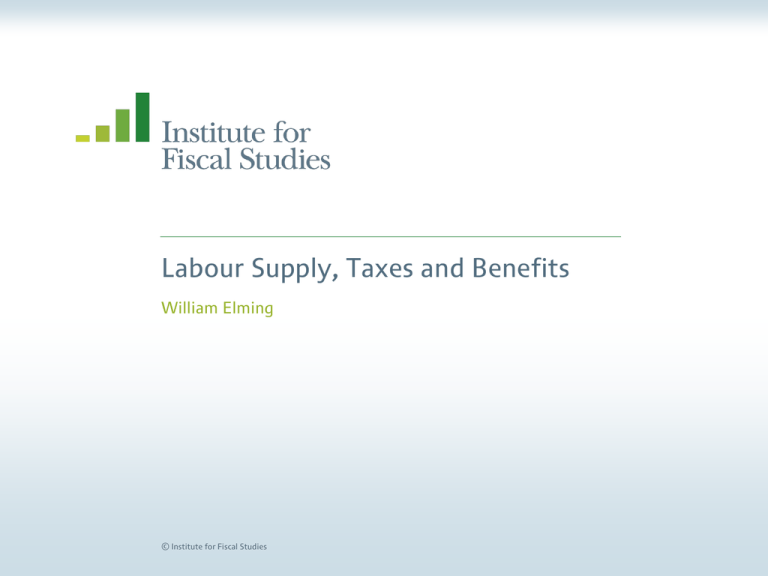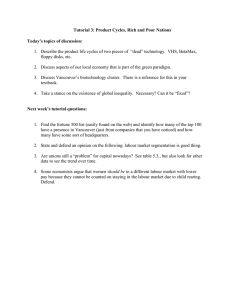Labour Supply, Taxes and Benefits William Elming © Institute for Fiscal Studies
advertisement

Labour Supply, Taxes and Benefits William Elming © Institute for Fiscal Studies Introduction • Effect of taxes and benefits on labour supply a hugely studied issue in public and labour economics – why? • Significant policy interest in topic – How should we design the tax and benefit system to encourage individuals on the margins of the labour market into employment? – What are the consequences of raising top income tax rates? • Central to understanding interesting labour market phenomena – Substantial increase in employment rates among women – Role of LS in driving business cycle fluctuations • Plan for this lecture – Outline simple static model of labour supply with proportional taxes – Discuss alternative methods of identifying effect of taxes on LS – On the way, introduce some empirical work in the field © Institute for Fiscal Studies Basic notions • How should we measure labour supply? – Extensive margin: whether to work or not – Intensive margin: how much to work. Just hours? What about effort? – Individual or joint family decision? – “Quality adjusted” labour supply (human capital, education and training) • How should we think about effect of taxes on labour supply? – Income and substitution effect – Summarise reaction of LS with elasticity measure (ε) • Focus here: intensive margin in a static framework – But many elasticity concepts: important to think about what the relevant one is • Differences between estimates can often be attributed to data measurement issues the importance of selecting covariates (see Blundell and MaCurdy, 1998) – Long run vs short run estimates © Institute for Fiscal Studies A static model of labour supply • With proportional taxes τt individual i with characteristics and preferences vit over consumption cit and leisure lit maximise – Max U(cit, lit, vit ) s.t cit = 𝜇it + (1-τt)wit( T - lit ) – where T is time endowment, 𝜇it non-labour income and τt is the tax rate – Yields labour supply function hit = hs((1-τt)wit, 𝜇it, vit) – Under certain conditions, have interior solution for hours of work • Have possible corner solution: zero hours – Work only if (1-τt)wit > w* = Ul/Uc evaluated at h=0 – Taxes unambiguously reduce probability of working versus τt = 0 © Institute for Fiscal Studies Effect of taxes on labour supply • Uncompensated (Marshallian) elasticity defined as εu = w/h * dhs/dw [%change in hours when net of tax wages increases with 1%] • Compensated (Hicksian) elasticity (substitution effect) • By Slutsky have εc = εu– η where η is the income effect – Note εc determines distortionary costs of taxation • How do we go about identifying these effects of interest? © Institute for Fiscal Studies Estimating the elasticity directly • Model suggests hours worked are a function of marginal net-of-tax hourly wages (1-τ) (w) and other income (𝜇) • So why not just get some cross-sectional data and run regression of • Problems? – Selection: only observe wages for individuals in work • Running regression only on observations with positive hours means can bias estimates: low wage earners must really like work -> selection correction – Omitted variable bias - w correlated with tastes for work – Progressive taxes => reverse causality ((1-τ)w depends on h) – Measurement error: results in attenuation bias – Non-hours response (see later) © Institute for Fiscal Studies (Quasi) Natural Experiments • Variation from tax reforms provide potential solution to these issues – Policy might act as exogenous source of variation, changing tax rates for some `treatment group’ but not another `control group’ – Diff-in-diff approach : compare labour supply responses of ‘treated’ group to that of ‘untreated’ group – Key assumption: common trends (and no group compositional change) • Lots of work exploiting the 1986 Tax Reform Act in US – E.g. Eissa (1995): high income women saw large reductions in marginal rates -> income and substitution effect • Treatment: Married women 99th percentile, Controls: from 75th percentile – Find small increase in hours, large increase in participation for ‘treated’ – Problems: differential shocks, assortative matching, other reforms, group composition affected by reforms – See Blundell, Duncan & Meghir (1998) for a more credible approach © Institute for Fiscal Studies Discrete choice (structural) models • • • Discrete choice models used to estimate labour supply in the presence of non-linear budget sets – e.g. decision is to work full-time, part-time, or not at all – Can identify “deep” labour supply parameters of interest – Once behavioural parameters have been uncovered, we can potentially simulate effects of hypothesised policy reforms – But requires (restrictive) assumptions on preferences and error terms Example: Brewer et al (2006) – Examine effect of 1999 WFTC reform in UK on labour supply of mothers – Find reform increased employment rate of lone mothers by around 5ppt but slightly reduced labour supply of couples with children See Blundell et al. (2007) for survey of approach © Institute for Fiscal Studies New tax responsiveness literature • Individuals might respond on margins other than hours/employment – • • Intensity of effort; human capital investment; income shifting New tax responsiveness literature: look instead at taxable income – Taxable income a proxy for total effort: includes various channels – ETI: if net-of-tax rate (1-τt) rises by 1%, taxable income rises by X% – Feldstein (1995): ETI a `sufficient statistic’ for welfare analysis (under some conditions) – But ETI is not a “deep” economic parameter – see Saez et al. (2012) for a good critical overview Basics of approach – Summary parameter indicating how responsive taxpayers are to changes in their marginal tax rate – Compare taxable income of some group affected by a reform to that of an unaffected group © Institute for Fiscal Studies Example: the 50p rate of income tax debate • Budget 2009 announced introduction of 50p rate of income tax for those with incomes above £150,000 from April 2010 – Affects less than 1% of adults – At the time, HMT scored measure as increasing tax revenues by £2.7bn a year post-behavioural response (£6.8bn pre-response) • In Budget 2011, the Chancellor asked HMRC to produce a report on how much 50p rate was raising – Suggested yield of £1 billion using revised estimate of the ETI – Revised estimate based on work exploiting the reform • Revenue yield sensitive to estimated ETI © Institute for Fiscal Studies Revenue yield highly sensitive to the ETI Taxable income elasticity Revenue raised by 50p rate assuming: 0.20 Indirect tax revenues unaffected (£ billion) 4.1 Expenditure falls as much as income (£ billion) 2.9 0.25 3.5 2.2 0.30 3.0 1.6 0.35 2.4 0.9 0.40 1.8 0.3 0.45 1.3 –0.4 0.46 1.1 –0.5 0.50 0.7 –1.0 Source: Browne (2012) IFS Green Budget © Institute for Fiscal Studies How did the HMRC estimate the ETI? • HMRC produced estimate of income growth in 2009–10 and 2010–11 among those with incomes above £150k in the absence of the 50p rate, using information on: – income growth among the group with incomes between £115k and £150k in 2009–10 and 2010–11 and – stock market growth 2009–10 and 2010–11 • For this estimate to be unbiased, requires income growth among those with lower incomes to be unaffected by reforms. Unlikely: – If people reduce their income below £150k in response to 50p rate, would increase total income of this lower income group – Lower income group may also be affected by other policies introduced at the same time or differently by economic shocks • Affected individuals might bring income forward to 40p regime: – HMRC estimate suggests £16bn to £18bn shifted forward to 2009– 10 – Particularly important for individuals with dividend income © Institute for Fiscal Studies HMRC estimate of the ETI • HMRC estimate of the elasticity of taxable income – Central estimate of 0.48: if net-of-tax rate rises by 1%, taxable income rises by 0.48% => 50p rate raises £1 billion relative to 40p • But estimates produced by their model are very imprecise – Standard errors suggest that only two-thirds chance that true elasticity in the model is between 0.14 and 0.81 – And as we saw, revenue estimates are highly sensitive to the ETI • Overall, reasonable attempt using approach – Similar to IFS central estimate of 0.46 (based on tax cuts in the 1980s) – But estimated parameter depends on avoidance opportunities: suggests government can (to an extent) increase the revenue maximising rate by reducing avoidance opportunities • See Saez et al JEL 2012 for critical review of literature: mean reversion, anticipation effects, re-allocation over the lifecycle © Institute for Fiscal Studies Recent work on tax credit and benefit cuts and the new NLW • As part of his deficit reduction plan the Chancellor aims to eliminate the deficit between 2015 and 2020 • Government plan £12bn cut to annual benefit spending by end of the parliament – Cuts to UC for those in work [the cuts to tax credits from April 2016 proposed in the summer Budget were rolled back in the 2015 Autumn statement] – A four-year freeze to most working age benefits and tax credits – A cut in credit amounts for new claimants with children from April 2017 - especially for families with 3+ children • Introduced a higher minimum wage for adults aged 25 and over, the new “National Living Wage” (NLW) © Institute for Fiscal Studies Effects on work incentives? • Cutting out-of-work benefits induces individuals to work more (lower income, they get to keep more if they move into work) • The cuts to in-work benefits will weaken incentives to work • The new NLW will also affect households earnings 1. Labour supply effect • 2. Labour demand effect • • If there is not a strong income effect then a higher NLW will induce individuals to work more hours (substitution effect) Firms will want to hire less workers/offer less hours (unless productivity increases) In total, the tax and benefit reforms, the new NLW and the move to Universal Credit will, on average, strengthen work incentives slightly – © Institute for Fiscal Studies Different for different groups (e.g. Lone mothers) Summary • Understanding effect of taxes on labour supply crucial for many areas of policy and bigger questions about labour market trends • But identifying behavioural responses and LS parameters difficult • – Endogeneity and selection hamper standard OLS approach in x-section – Hard to find credible treatment-control groups for experimental design Yet relative consensus on labour supply responses – Prime-aged males very unresponsive in intensive and extensive margin, but taxable income elasticities around 0.2-0.6 – Married women more sensitive, particularly on extensive margin – Presence and age of children in household important – See Meaghir & Philips (2010) for accessible survey, and Blundell and MaCurdy (1999) for more comprehensive one © Institute for Fiscal Studies 4. Bibliography • Blundell, R., Duncan, A., Meghir, C., 1998. Estimating Labor Supply Responses Using Tax Reforms. Econometrica 66, 827. • Blundell, R., Macurdy, T., 1999. Chapter 27 Labor supply: A review of alternative approaches, in: Orley C. Ashenfelter and David Card (Ed.), Handbook of Labor Economics. Elsevier, pp. 1559–1695. • Blundell, R., MaCurdy, T., Meghir, C., 2007. Chapter 69 Labor Supply Models: Unobserved Heterogeneity, Nonparticipation and Dynamics, in: James J. Heckman and Edward E. Leamer (Ed.), Handbook of Econometrics. Elsevier, pp. 4667–4775. • Brewer, M., Duncan, A., Shephard, A., Suárez, M.J., 2006 Did working families’ tax credit work? The impact of in-work support on labour supply in Great Britain. Labour Economics 13, p699-720. • Feldstein, M., 1995. The Effect of Marginal Tax Rates on Taxable Income: A Panel Study of the 1986 Tax Reform Act. Journal of Political Economy 103, 551–572. • Philips, D., Meghir, C., Labour Supply and Taxes, in: Dimensions of Tax Design: The Mirrlees Review. • Saez, E., 2010. Do Taxpayers Bunch at Kink Points? American Economic Journal: Economic Policy Vol 2, 180–212. • Saez, E., Slemrod, J., Giertz, S.H., 2012. The Elasticity of Taxable Income with Respect to Marginal Tax Rates: A Critical Review. Journal of Economic Literature 50, 3–50. © Institute for Fiscal Studies







